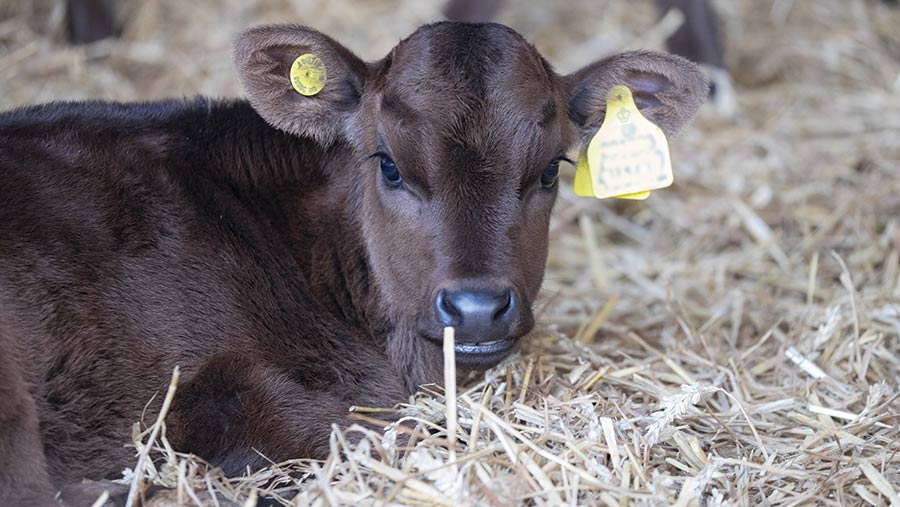How to stop calf pneumonia reducing heifer longevity
 © Tim Scrivener
© Tim Scrivener Calf pneumonia has stayed in the top 10 of the most frequent diagnoses from carcass submissions* in Great Britain for almost a decade.
And while heifers can recover and eventually join the milking herd, there is long-term damage.
See also: Why calf cough is unreliable as early warning for pneumonia
Pneumonia has a consistent and lasting impact on growth rates and production.
Research shows that the average difference in milk production between heifers that had pneumonia as calves and those that did not was 121kg of milk in a 305-day lactation.
But what is most important is the range, says AHDB Dairy senior scientist Dr Jenny Gibbons.
“The biggest difference was 525kg of milk and the smallest was 70kg,” she says.
“We know that heifers with pneumonia are more likely to be removed from the herd at any time before their first lactation, compared with those that do not get pneumonia.
“This means they are more likely to be culled or sold before repaying their rearing costs.”
While death and losses increase the overall cost of heifer rearing, Jenny points out that it is likely that many cases go unnoticed.
“Studies reveal that when 30% of cattle in a group show actual signs of respiratory disease, a further 40% can exhibit lung damage at slaughter,” she adds.
Pneumonia cost
Estimates of the cost of pneumonia in UK beef and dairy calves put the figure at £772 for an infected animal in 2017.
Dr Ginny Sherwin, clinical associate professor in farm animal medicine at Nottingham University, says this cost is not just for treatment.
“There is a delay in weaning because of a lower daily liveweight gain; this then increases age at first calving.
“Heifers produce 4% less in their first lactation and 8% less in their second lactation, and longevity is reduced by 109 days,” she explains.
There is now evidence that scours in calves are an entry to pneumonia, even though the risk factors are different, she says.
This may help in prevention because it is very difficult to detect pneumonia early enough to use anti-inflammatories.
“Treatment is usually a broad-spectrum antibiotic, because the vast majority of cases are mixed, starting with a virus, then a secondary bacterial infection,” she says.
However, Ginny points out that recovery and relapses are hugely variable on a farm-by-farm basis.
“It all depends on how quickly you can treat and what the environmental conditions are like. Also, calves can be looked after by less-knowledgeable and less-skilled labour.”
Stress management
There are many factors in preventing calf pneumonia – but no magic bullet.
And vaccination only helps reduce the severity of a case, it will not prevent it.
Ginny thinks the key issue is stress management. But what causes stress will be farm-specific and vary depending on calving pattern, farm facilities, labour and resources.
It is not just about taking precautions in a foggy November.
“Calves that are stressed become run down and more susceptible to disease because stress plays a big role in the host, bug and environment interaction,” she says.
“Environmental stressors range from group sizes and age ranges to calves reared in single pens, poor housing and frequent changes.
“If we don’t feed them enough and they are cold, they will divert energy away from their immune system and growing to keeping warm.”
Steps to help prevent calf pneumonia
Colostrum
Make sure calves have enough good-quality colostrum for their immunity. Test the quality and aim for 61+mg/decilitre, showing as 8.4% on a Brix refractometer.
Also, remember that colostrum provides more than immunoglobulins: it is a source of nutrients and hormones that have an impact on short- and long-term performance.
Feeding enough milk
Calves will naturally drink 12-15 litres a day, so think about mimicking nature in terms of feeding amount, how it is fed and the milk constituents.
Reduce stress
Look at reducing group movements, rearing calves together, timing of disbudding and the process of weaning.
Housing
Look at cold stress, environmental temperature, draughts and air quality.
Training staff and boosting staff morale
Calf rearing is a team effort and has to involve everyone to ensure consistency and early detection of problems.
Source: Dr Ginny Sherwin
*Animal and Plant Health Agency/Scotland’s Rural College surveillance GB quarterly cattle report, April to June 2023
